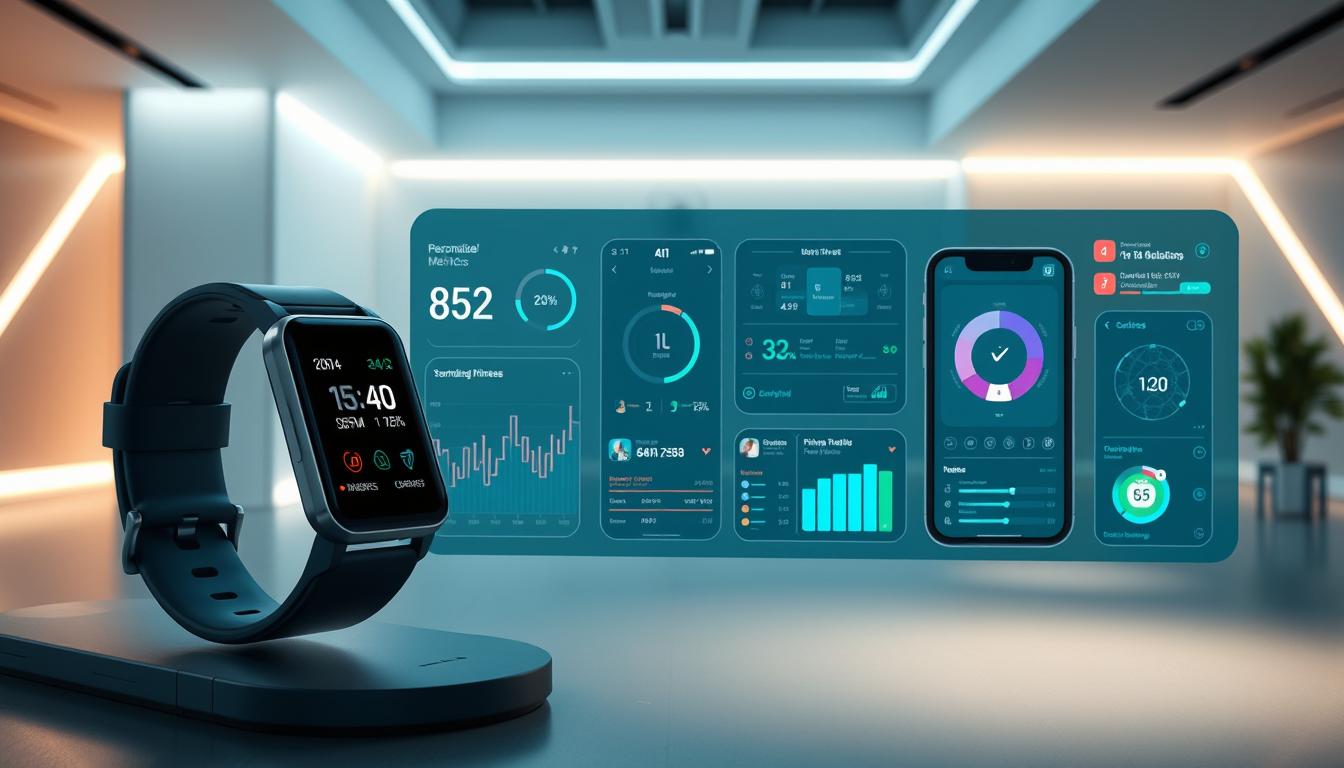Are you tired of workout routines that don’t work? AI technology is changing the fitness landscape fast.
The future of fitness is all about personalization. AI apps will learn your habits, adapt to your needs, and motivate you. As we get closer to 2025, everyone wonders: What will these AI fitness apps bring?
Key Takeaways
- AI-powered fitness apps will revolutionize fitness.
- Personalization will be key to reaching fitness goals.
- AI advancements will make workouts more effective.
- Users will enjoy a more engaging and motivating fitness journey.
- The future of fitness will use data to drive results.
The Digital Fitness Revolution: Where We Are Today
Today, technology rules the fitness world, tracking, analyzing, and motivating us. You’re part of a growing group using digital tools to reach fitness goals. Fitness tech has come a long way, from simple step counters to advanced systems that offer personalized advice and feedback.
From Basic Step Counters to Intelligent Fitness Companions
At first, fitness tech was just about counting steps. Now, devices and apps track a variety of activities, like running and yoga. They’ve become intelligent fitness companions, giving you tailored advice and motivation.

But, today’s fitness tech has its limits. Many struggle to offer personalized experiences, using generic data that doesn’t fit everyone. Also, devices and apps often don’t work well together, making the experience disjointed.
Why Traditional Fitness Apps Fall Short
Traditional fitness apps don’t keep up with your changing needs. They might offer workout plans that get old fast. They also lack the AI insights needed to optimize your workouts and recovery.
The future of fitness tech is about creating smarter, more adaptable, and user-focused solutions. By understanding today’s tech limits, we can look forward to the innovations coming our way.
Fitness Trends in 2025: Apps That Learn, Adapt, and Motivate
In 2025, fitness apps will change how we work out. They will learn, adapt, and motivate us in new ways. These apps will understand what we need and like.
The Core Technologies Driving Next-Generation Fitness
At the center of these new apps are machine learning and predictive analytics. These tools help apps understand your workout habits. They then suggest changes to keep you motivated and on track.
Machine Learning and Predictive Analytics
Machine learning looks at lots of data to find patterns in your fitness. Predictive analytics then guesses how you’ll do next. This lets the app create workouts that are just right for you.

How These Apps Will Transform Your Fitness Journey
The old way of fitness is fading away. With these apps, you’re on a personalized fitness journey. It’s designed to help you reach your goals.
The End of One-Size-Fits-All Fitness
These apps use machine learning and predictive analytics. They make sure your workouts match your goals and fitness level. This makes every workout count.
Trend 1: Hyper-Personalized AI Workout Design
Hyper-personalized AI is changing how we work out. It creates tailored exercise plans based on our unique needs and genetics. This is a big change for the fitness world.
Beyond Basic Algorithms: True Personalization
Hyper-personalized AI workout design uses lots of data. It looks at our genetics and how our bodies work. This makes sure workouts are safe and effective for each person.
Genetic and Physiological Data Integration
AI looks at genetic data and physiological metrics to plan workouts. It finds the best exercises and how hard to do them. This helps us reach our fitness goals faster.
| Data Type | Usage in Workout Design | Benefits |
|---|---|---|
| Genetic Data | Identifying genetic predispositions to certain fitness outcomes | Tailored workout plans to maximize genetic pote |
| Physiological Data | Monitoring heart rate, muscle recovery, and other physiological metrics | Optimized workout intensity and recovery strategies |
Continuous Learning From Your Performance
AI workout systems learn from how you do. They change your plan as you get better. This keeps your workouts challenging but doable.
Adapting to Your Daily Energy Levels and Recovery State
These AI systems also watch your daily energy levels and recovery state. They adjust your plan to avoid too much work and injury. This helps you keep getting better without burning out.
Trend 2: Adaptive Training Systems That Evolve With You
The fitness world is changing fast with new training systems. These systems adjust to your progress and needs. They offer a more personalized and effective way to work out.
Dynamic Workout Adjustments in Real-Time
Adaptive training systems use advanced algorithms for dynamic workout adjustments in real-time. Your workout routine changes based on your performance, like heart rate and speed.
Micro-Progressions Based on Performance Metrics
These systems make micro-progressions based on your performance. They analyze your workout data to find areas for improvement. Then, they adjust the intensity and volume of your workouts.
Intelligent Recovery Programming
Intelligent recovery programming is key in these systems. They focus on your recovery from workouts. By looking at your recovery data, they adjust your workout schedule to avoid overtraining.
Preventing Plateaus and Overtraining
Adaptive training systems keep an eye on your progress and adjust your workouts. This helps prevent plateaus and overtraining. You’ll keep making progress towards your fitness goals without injury or burnout.
In summary, adaptive training systems are a game-changer in fitness. They offer dynamic workout adjustments and smart recovery plans. This leads to a more effective and personalized fitness experience.
Trend 3: Behavioral Science-Backed Motivation Techniques
The fitness world is changing fast, thanks to new trends. Fitness apps are now more than just tracking tools. They use science to understand and change how we behave.
Personalized Motivation Profiles
One big leap is the creation of personalized motivation profiles. These profiles use data and science to figure out what makes you move. They look at what you like, when you like it, and who you like to do it with.
Identifying What Drives Your Specific Fitness Behavior
Apps analyze your data to find out what really gets you moving. It might be your favorite workout times, the exercises you love, or the people you work out with. Knowing these things helps make fitness plans that really work for you.
Habit Formation and Consistency Building
Getting you to exercise regularly is the next big challenge. Science-backed methods help with habit formation and consistency building. They use psychology to make exercise a part of your daily routine.
Neuropsychology-Based Reward Systems
Neuropsychology-based reward systems play a key role here. They aim to make your brain happy by releasing feel-good chemicals. This creates a cycle of positive reinforcement for regular exercise.
For example, an app might give you badges, show you on leaderboards, or send you personalized messages. The goal is to make these rewards meaningful and personal, boosting your motivation.
Trend 4: Immersive Fitness Through AR and VR Integration
In 2025, fitness trends are all about immersive experiences with AR and VR. These technologies are changing the game by making workouts more fun, interactive, and tailored to you.
Virtual Training Environments That Respond to You
Imagine training in a virtual world that changes based on how you do and what you like. AR and VR are creating immersive workout places. You can go from peaceful nature scenes to lively gyms. These places make working out more fun and boost your motivation.
Location-Based Workouts and Global Destinations
AR and VR let you go on virtual fitness trips around the world. You can run in Tokyo or cycle in California from home. It’s a thrilling way to mix up your workouts and explore new places.
Gamification Elements That Boost Adherence
Gamification is big in immersive fitness apps. They add fun elements like challenges, rewards, and leaderboards. This makes working out more enjoyable and competitive, pushing you to reach your goals.
Achievement Systems That Maintain Long-Term Engagement
Achievement systems are key to keeping you going long-term. You earn badges, unlock levels, and hit milestones. This gives you a sense of achievement and keeps you motivated to keep working out.
Trend 5: Seamless Wearable Ecosystem Integration
Seamless wearable ecosystem integration is changing the fitness world. It offers a complete view of health and wellness. This trend adds advanced features for a better user experience, making tracking easier and more intuitive.
Advanced Biometric Tracking Beyond Heart Rate
Today’s wearables do more than just track heart rate. They offer:
- Monitoring physiological signals for overall health
- Providing detailed insights into physical condition
- Enabling more precise fitness and wellness tracking
Stress, Hydration, and Metabolic Monitoring
New wearables track stress, hydration, and metabolism. These features help users understand their body’s response to exercise and daily life.
Stress monitoring helps users spot high-stress times. They can then take steps like meditation or deep breathing. Hydration tracking keeps users hydrated. Metabolic monitoring shows how calories are burned.
Cross-Device Synchronization and Smart Home Integration
Cross-device synchronization is key in wearable integration. It lets users see their fitness data on different platforms, for a smooth experience.
Creating a 24/7 Fitness Environment
Wearables connect with smart homes for a 24/7 fitness environment. Users can control their home’s settings from their wearable. This improves their fitness and wellness journey.
For example, a wearable can set the home’s temperature for recovery after a workout. It can also dim lights for sleep, based on the user’s schedule.
By linking wearable tech with smart devices, users get a seamless and connected fitness journey. This new approach to fitness is changing how we view health and wellness in 2025.
Trend 6: AI Coaches With Human-Like Interaction
The fitness world is changing fast with AI coaches that talk like humans. They make workouts better and more personal. These systems do more than just follow a routine. They get to know you, adjust to how you do things, and give feedback right away.
Computer Vision for Real-Time Form Correction
Computer vision is a big part of AI coaches. It lets them check your form while you work out. Cameras and AI look at how you move, spot problems, and tell you how to get better.
Preventing Injuries Before They Happen
AI coaches fix your form as you go, which helps avoid injuries. This keeps you safe and makes sure you get the best from your workouts.
Conversational AI for Personalized Guidance
Conversational AI is key for AI coaches that feel like friends. They talk naturally, giving you advice, motivation, and support on your fitness path.
Emotional Intelligence in Virtual Coaching
AI coaches also understand and care about how you feel. They offer empathy and support, which is great during tough times or when you’re feeling down.
AI coaches use computer vision, conversational AI, and emotional intelligence. They’re changing fitness, making workouts more personal, effective, and fun.
Trend 7: Community-Building Through Shared Fitness Goals
Fitness apps are now using community-building strategies to connect users. You’re no longer alone in your fitness journey. These apps create a supportive ecosystem that motivates you to reach your goals.
Meaningful Social Connections Beyond Basic Leaderboards
Traditional leaderboards often don’t create lasting connections. Modern fitness apps are moving beyond simple rankings. They foster genuine social interactions through innovative features.
AI-Matched Workout Partners and Groups
Imagine being matched with workout partners or groups that share your fitness goals and preferences. AI-driven algorithms can now pair you with like-minded individuals. This approach boosts your motivation and accountability. It makes sticking to your fitness regimen more likely.
Competitive Elements That Drive Performance
Competition can be a powerful motivator. Fitness apps are adding competitive elements that drive performance without losing the sense of community. You can take part in friendly competitions that push you to do more.
Virtual Group Challenges and Team-Based Goals
Virtual group challenges and team-based goals are getting more popular. These features let you join structured programs with others who have the same goals. They foster camaraderie and shared achievement.
| Feature | Description | Benefits |
|---|---|---|
| AI-Matched Partners | Personalized matching with workout partners or groups based on goals and preferences. | Increased motivation, accountability, and social interaction. |
| Virtual Challenges | Participation in virtual group challenges and team-based fitness goals. | Enhanced competition, camaraderie, and achievement. |
By adding these community-building features, fitness apps help you achieve your fitness goals. They also create a supportive network that celebrates your progress.
Trend 8: Holistic Wellness Integration
The future of fitness is about more than just working out. It’s about taking care of your whole self. This means tracking your workouts, nutrition, sleep, and mental health. It’s about being fit in body, mind, and spirit.
Personalized Nutrition Recommendations Based on Activity
Personalized nutrition is key to holistic wellness. Fitness apps will look at your activity, diet, and health goals. Then, they’ll suggest meals just for you.
Real-Time Meal Suggestions and Timing
These apps will give you real-time meal suggestions and when to eat them. This helps you get the nutrients you need before and after workouts. It boosts your recovery and performance.
| Nutrition Aspect | Traditional Approach | Holistic Approach |
|---|---|---|
| Meal Planning | Generic meal plans | Personalized meal suggestions based on activity |
| Timing | No specific timing recommendations | Real-time timing suggestions for optimal nutrient intake |
Sleep and Recovery Optimization
Sleep optimization is vital for recovery. Holistic fitness apps will track your sleep. They’ll give you tips to improve your rest.
Stress Management and Mental Wellness Features
These apps will also help with stress management and mental wellness. You’ll find guided meditations and breathing exercises. They’re designed to help you relax and stay mentally balanced.
With these features, fitness apps will offer a complete wellness experience. They support your journey to better health and fitness.
Trend 9: Data Privacy and Ethical AI in Fitness
The future of fitness is about more than just personalized workouts and AI coaches. It’s also about keeping your personal health information safe. As fitness tech grows, protecting your data and using AI ethically is more important than ever.
Securing Your Personal Health Information
Your fitness data is very sensitive. It’s key to keep it safe. Today’s fitness apps are working hard to protect your health info.
User Control Over Data Sharing and Usage
Having control over your data is a big part of privacy. You should be able to choose who sees your info and how it’s used. It’s important for apps to be open about how they handle your data to build trust.
Transparency in Algorithm Decision-Making
The algorithms in your fitness app are complex. It’s important to know how they make decisions. This helps make sure AI is used ethically.
Ethical Considerations in Fitness AI Development
AI developers must think about the ethics of their work. They should avoid bias and make sure the AI promotes healthy habits without being too pushy.
By focusing on data privacy and ethical AI, fitness tech can keep improving while respecting your rights. Finding this balance is key for the success of fitness apps and the health of their users.
Conclusion: Embracing the Future of Fitness Technology
Looking ahead to 2025, fitness technology is set to change how we reach our fitness goals. Advances in AI, AR, VR, and wearables are making fitness apps more tailored and engaging. These technologies help make your fitness journey more effective and fun.
The trends we’ve discussed, like AI-designed workouts and holistic wellness, will change fitness. It’s key to keep up with these changes in fitness tech. This way, you can reach your fitness goals and live a healthier life.
Embracing new fitness tech means being ready for growth and new chances. As these innovations come, your fitness journey will get better. By staying updated, you’ll enjoy the latest in fitness tech.


